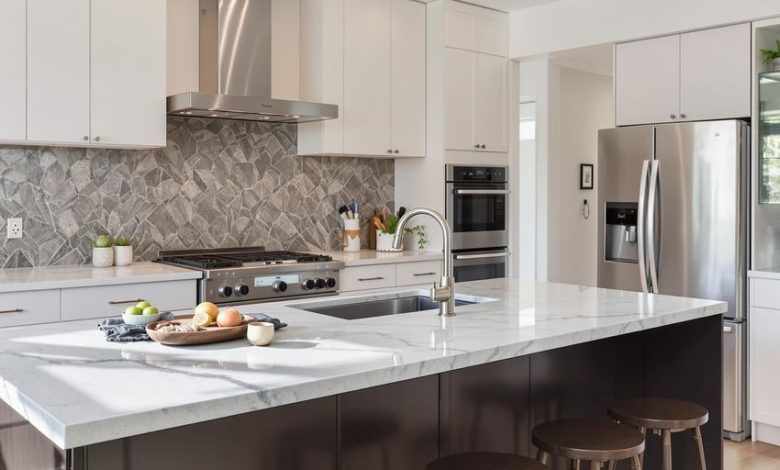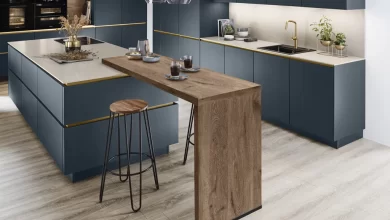Transform Your Space with Stunning Gray Quartz Countertops: The Ultimate Guide

Understanding the Allure of Gray Quartz
The Science Behind Quartz: Why It Reigns Supreme
Quartz countertops have become one of the most sought-after materials in the market, a trend that can be attributed to both their aesthetic appeal and their performance. Engineered quartz is composed of approximately 90% crushed natural quartz crystals mixed with resins and pigments. This combination not only enhances its durability—making it impervious to cracking and chipping—but also imparts a vast array of colors and patterns, including the stunning grays that are so prevalent today. Unlike natural stones like granite or marble, quartz surfaces provide a non-porous option, meaning they do not harbor bacteria or require sealing, making them both an excellent and hygienic choice for kitchens and bathrooms alike.
Color Psychology: The Calming Effect of Gray in Design
Gray is often misconstrued as dull or dreary, but in the realm of design, it serves as an incredibly versatile backdrop. Color psychology reveals that gray promotes neutrality and calmness, making it an ideal choice for spaces intended for relaxation, such as kitchens and living areas. It provides a beautiful canvas for art and decorative elements and has the unique ability to shift in tone depending on the surrounding light—warm in natural light, cool under artificial lighting. The calming aura of gray can extend to its combination with other shades, creating a serene and harmonious aesthetic. When paired with whites, soft blues, and even darker hues, gray quartz countertops can enhance the overall mood of your home, fostering a sense of tranquility.
Exploring the Versatility of Gray Quartz in Different Aesthetics
Whether your home embodies modern minimalism, rustic charm, or traditional elegance, gray quartz countertops find a way to fit beautifully. In contemporary designs, you might find sleek, flat finishes in light, creamy grays that provide an unobtrusive backdrop, allowing other elements like cabinetry or backsplash tiles to shine. Conversely, in a farmhouse-style kitchen, darker gray quartz with veining can mimic the look of weathered stone, enhancing the cozy feel that is characteristic of this aesthetic. This adaptability extends beyond mere color and pattern; the material’s seamless finish allows for creative installation features such as waterfall edges and integrated sinks, amplifying your design’s signature look.
Choosing the Perfect Gray Quartz for Your Space
Different Shades and Patterns: What Fits Your Style?
When selecting gray quartz, it is essential to consider the multitude of options available, ranging from light dove grays to deep charcoal tones. Each shade can evoke a different atmosphere, which plays a critical role in how the space feels overall. For instance, a light gray countertop exudes openness and warmth, making it an excellent choice for smaller kitchens seeking an airy feel, while a dark gray can instill a sense of sophistication and modernity, ideal for larger spaces or gourmet kitchens. Patterns also vary widely; some quartz slabs feature delicate speckling, while others boast bold veins that mimic natural stone. An understanding of your home’s existing color palette, furnishings, and lighting can guide these choices effectively.
Quality Matters: How to Spot High-Grade Gray Quartz
When investing in gray quartz countertops, quality should always take precedence. Factors contributing to quality include the percentage of natural quartz used, the resin quality, and the manufacturing process. Premium quartz countertops typically consist of around 93% quartz, which creates a denser and more resilient surface capable of withstanding everyday wear and tear. Additionally, reputable brands will provide certifications, such as those from the American National Standards Institute (ANSI) and the National Sanitation Foundation (NSF), indicating that they meet industry standards for safety and quality. It’s also wise to consider the supplier’s warranty policy; a comprehensive warranty can be indicative of a product’s longevity and quality assurance.
Textures and Finishes: Enhancing Your Quartz Experience
The texture and finish of your gray quartz countertops can significantly influence both their appearance and functionality. Common finishes include polished, honed, and satin, each providing a distinct character. Polished finishes are highly reflective, emphasizing the depth and intricacies of the stone while making it easier to clean, though they may be more susceptible to scratches. On the other hand, honed finishes offer a more understated, matte look, which can be perfect for rustic or contemporary designs but may require more frequent maintenance to keep stains at bay. Satin finishes fall between the two, offering a subtle sheen that’s both attractive and practical. Depending on your lifestyle, understanding these finishes can empower you to select a countertop that balances beauty with everyday usability.
Installation Insights: Bringing Your Vision to Life
DIY vs. Professional Installation: Pros and Cons
The decision to install gray quartz countertops yourself or hire a professional hinges on various factors, including budget, skill level, and time constraints. DIY installation can be an appealing option for those with sufficient experience and the right tools, potentially saving on labor costs. However, it’s crucial to acknowledge the complexities involved—seams must be precise, and the countertops need to be properly supported to avoid cracking. Conversely, hiring professionals ensures that the installation is executed with precision and care, with many installers also offering warranties on their work. While the upfront cost may be higher, the peace of mind gained from professional-quality workmanship often outweighs the expense. Thus, assessing your proficiency and the countertop’s complexities is essential when making this decision.
Preparing Your Space: What You Need to Know
Preparation is key to a successful quartz countertop installation. First, ensure that the base cabinetry can bear the weight of the quartz, which can weigh over 20 pounds per square foot. Leveling the cabinetry is essential, as uneven bases can result in cracks and misalignment. It’ll be beneficial to measure the area meticulously, taking into account factors such as overhangs and the location of sinks and appliances. Moreover, clearing the space of any debris, ensuring plumbing and electrical work is complete, and aligning the timing with the delivery of the quartz slabs are crucial steps that should not be overlooked. Being thorough in preparation not only facilitates a smoother installation process but can also save you time and reduce potential costs from errors.
Common Installation Pitfalls and How to Avoid Them
Even seasoned professionals can encounter installation pitfalls, so being aware of common issues can help ensure a flawless outcome. One prevalent challenge is improper seam alignment, which can lead to visibly flawed countertops. To counteract this, meticulous measurements are necessary, and it’s advisable to set all slabs in place prior to adhering them to ensure they fit properly. A lack of proper support for the countertop can also result in cracks; utilizing brackets, corbels, or supports can prevent this. Finally, working with adhesive in extreme temperatures can create bonding failures—ideally, the installation should occur in moderate temperatures. By being informed about these common pitfalls, you can better prepare to prevent them, whether you’re undertaking the project yourself or guiding a professional team.
Maintaining the Beauty of Your Gray Quartz Countertops
Cleaning Do’s and Don’ts: Keeping Your Countertops Pristine
To maintain the allure of gray quartz countertops, regular care is essential. Fortunately, maintaining quartz is manageable, given its non-porous nature. The best method for cleaning consists of warm water and mild dish soap, applied with a soft cloth or sponge. This routine will eliminate most common stains without the risk of damage. However, it’s essential to avoid abrasive cleaners, steel wool, or excessive scrubbing pads, which can dull the finish. Additionally, acidic substances such as lemon juice or vinegar should be handled cautiously, as they can harm the resin if left unattended. Ultimately, adhering to a gentle cleaning regimen will prolong the beauty and functionality of your countertops.
Long-Term Care: Protecting Against Chips and Stains
While quartz countertops are known for their durability, long-term care is vital to protect against potential chips and stains. One preventive step includes using cutting boards to avoid scratching the surface during food preparation. Additionally, placing hot items directly from the oven or stove on quartz can lead to thermal shock, which may result in cracks—always use trivets or heat pads as a precaution. For stain protection, promptly cleaning spills, especially from pigments like wine or tomato sauce, can mitigate long-lasting discoloration. By implementing these protective measures, homeowners can ensure that their gray quartz surfaces withstand the test of time while retaining their stunning appearance.
Restoring Luster: Tips for Reviving Your Gray Quartz
Over time, even well-maintained quartz can lose its initial luster, but restoration is typically straightforward. For minor surface dullness, a gentle cleanser with a soft cloth can revitalize the shine. If deeper scratches or stains persist, a specialized quartz polish available at home improvement stores can be applied following the manufacturer’s guidelines. For significant damage, however, it may be best to consult a professional who can assess and address more severe issues using methods that preserve the integrity of the surface. Remember that regular maintenance, including periodic polishing, can significantly enhance the longevity and beauty of your gray quartz countertops, ensuring they remain a centerpiece in your home for years to come.





